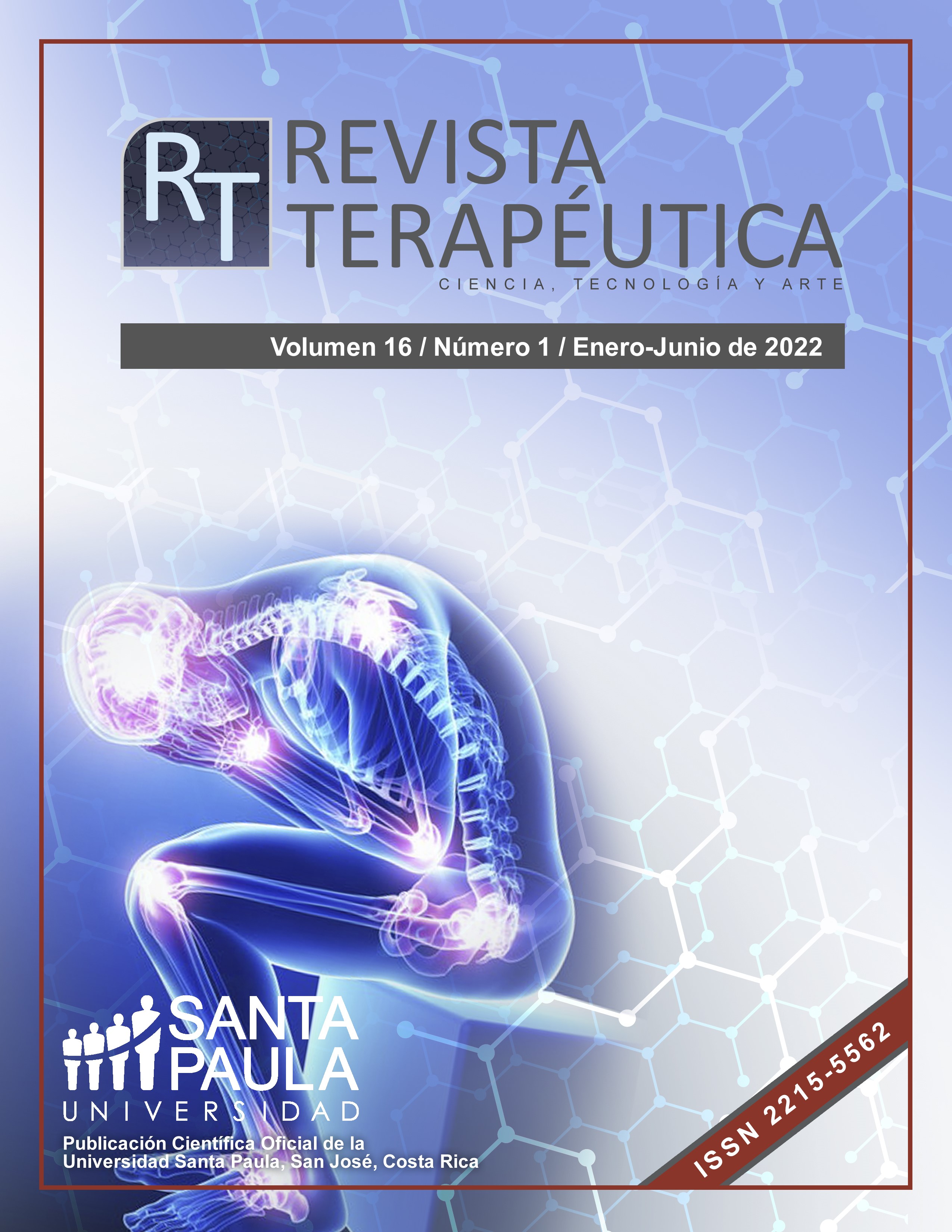Resumen
El propósito de este caso de estudio fue presentar la efectividad del tratamiento fisioterapéutico basado en técnicas ortopédicas manuales en un deportista aficionado con costocondritis por ejercicio físico intenso. Un deportista aficionado de resistencia de 31 años, experimentado, bien entrenado, que presentó dolor torácico sugestivo de costocondritis después de un examen físico y cinético. El paciente refirió presentar dolor después del esfuerzo físico en las últimas dos semanas (combinación de bicicleta de montaña, ciclismo de ruta, carrera, natación y yoga). La terapia manual que incluye técnicas como movilización por oscilación resonante de la región torácica, relajación post-isométrica de Lewit y deslizamiento de la cabeza humeral derecha, movilización con técnica de alta velocidad cervico-torácica, movilización activa asistida de la séptima a la décima costilla durante la fase espiratoria, inducción miofascial superficial en la zona costal inferior y, la técnica de potencia muscular, es eficaz para aliviar el dolor aumentar la movilidad de la rotación cervical, aumentar la movilidad de la articulación glenohumeral (p. ej., rotación interna), en un atleta aficionado con costocondritis debido al ejercicio físico extenuante.
Citas
Gregory PL, Biswas AC, Batt ME. Musculoskeletal Problems of the Chest Wall in Athletes. Sports Med. 2002;32(4):235-50. doi: 10.2165/00007256-200232040-00003.
Disla E, Rhim HR, Reddy A, Karten I, Taranta A. Costochondritis: A Prospective Analysis in an Emergency Department Setting. Arch Intern Med. 1994;154(21):2466-9. doi: 10.1001/archinte.154.21.2466
Ayloo A, Cvengros T, Marella S. Evaluation and Treatment of Musculoskeletal Chest Pain. Prim Care. 2013;40(4):863-87, viii. doi: 10.1016/j.pop.2013.08.007.
Hopper MA, Tirman P, Robinson P. Muscle injury of the chest wall and upper extremity. Semin Musculoskelet Radiol. 2010;14(2):122-30. doi: 10.1055/s-0030-1253156.
Malghem J, Vande Berg BC, Lecouvet FE, Maldague BE. Costal Cartilage Fractures as Revealed on CT and Sonography. AJR Am J Roentgenol. 2001;176(2):429-32. doi: 10.2214/ajr.176.2.1760429.
Hannan MT, Anderson JJ, Pincus T, Felson DT. Educational attainment and osteoarthritis: Differential associations with radiographic changes and symptom reporting. J Clin Epidemiol. 1992;45(2):139-47. doi: 10.1016/0895-4356(92)90006-9.
Rojas-Valverde D, Sánchez-García A, Sáenz-Ulloa D, Gutiérrez-Vargas R. Does Osteopathic Manipulation Lead to Improvements in Physical and Muscle Mechanical Function and Spinal Symmetries in Golfers? Kronos [Internet]. 2019;18(1):1-10. Disponible en: https://www.academia.edu/download/64853181/Kronos_Golf.pdf
Zaruba RA, Wilson E. Impairment based examination and treatment of costochondritis: a case series. Int J Sports Phys Ther [Internet]. 2017;12(3):458-67. Disponible en: https://www.ncbi.nlm.nih.gov/pmc/articles/PMC5455195/pdf/ijspt-12-458.pdf
Proulx AM, Zryd TW. Costochondritis: diagnosis and treatment. Am Fam Physician [Internet]. 2009;80(6):617-20. Disponible en: https://www.aafp.org/afp/2009/0915/afp20090915p617.pdf
De Pauw K, Roelands B, Cheung SS, de Geus B, Rietjens G, Meeusen R. Guidelines to classify subject groups in sport-science research. Int J Sports Physiol Perform. 2013;8(2):111-22. doi: 10.1123/ijspp.8.2.111.
Fam AG, Smythe HA. Musculoskeletal chest wall pain. CMAJ [Internet]. 1985;133(5):379-89. Disponible en: https://www.ncbi.nlm.nih.gov/pmc/articles/PMC1346531/pdf/canmedaj00268-0035.pdf
Ian Rabey M. Costochondritis: Are the symptoms and signs due to neurogenic inflammation. Two cases that responded to manual therapy directed towards posterior spinal structures. Man Ther. 2008;13(1):82-6. doi: 10.1016/j.math.2006.12.007.
Rovetta G, Sessarego P, Monteforte P. Stretching exercises for costochondritis pain. G Ital Med Lav Ergon [Internet]. 2009;31(2):169-71. Disponible en: https://citeseerx.ist.psu.edu/viewdoc/download?doi=10.1.1.533.2506&rep=rep1&type=pdf
González-Álvarez FJ, Valenza MC, Torres-Sánchez I, Cabrera-Martos I, Rodríguez-Torres J, Castellote-Caballero Y. Effects of diaphragm stretching on posterior chain muscle kinematics and rib cage and abdominal excursion: a randomized controlled trial. Braz J Phys Ther. 2016;20(5):405-411. doi: 10.1590/bjpt-rbf.2014.0169.
Hamaoui A, Le Bozec S, Poupard L, Bouisset S. Does postural chain muscular stiffness reduce postural steadiness in a sitting posture? Gait Posture. 2007;25(2):199-204. doi: 10.1016/j.gaitpost.2006.03.012.
Sandoval C, Díaz A, Manríquez G. Relationship between craniocervical posture and skeletal class: A statistical multivariate approach for studying Class II and Class III malocclusions. Cranio. 2021;39(2):133-140. doi: 10.1080/08869634.2019.1603795
de Oliveira LB, Cajaíba F, Costa W, Rocabado M, Lazo-Osório R, Ribeiro S. Comparative analysis of assessment of the craniocervical equilibrium through two methods: cephalometry of Rocabado and cervical range of motion. Work. 2012;41 Suppl 1:2563-8. doi: 10.3233/WOR-2012-0499-2563.
Rocabado M. The importance of soft tissue mechanics in stability and instability of the cervical spine: a functional diagnosis for treatment planning. Cranio. 1987;5(2):130-8. doi: 10.1080/08869634.1987.11678183.
Czaprowski D, Leszczewska J, Kolwicz A, Pawłowska P, Kędra A, Kriščiūnas A, et al. The Influence of Self-Stretching Based on Postisometrical Relaxation, Static Stretching Combined with Stabilizing Exercises, and Stabilizing Exercises Only on the Flexibility of One-Joint and Two-Joint Hip Flexors. Medicina (Kaunas). 2013;49(10):439-46. doi: 10.3390/medicina49100069
Emary P. Use of post-isometric relaxation in the chiropractic management of a 55-year-old man with cervical radiculopathy. J Can Chiropr Assoc [Internet]. 2012;56(1):9-17. Disponible en: https://www.ncbi.nlm.nih.gov/pmc/articles/PMC3280114/pdf/jcca-v56-1-009.pdf
Liebenson C. Self-treatment of mid-thoracic dysfunction: a key link in the body axis: Part Two: Treatment. J Bod Mov Ther. 2001;5(3):191-5. doi: 10.1054/jbmt.2000.0226
Pavón E. Eficacia del método POLD en el tratamiento de trastornos cervicales [Tesis de Licenciatura en Kinesiología]. Buenos Aires: Universidad FASTA; 2015. Disponible en: http://redi.ufasta.edu.ar:8080/xmlui/handle/123456789/810
López-Díaz JV, Arias-Buría JL, Lopez-Gordo E, Lopez Gordo S, Aros Oyarzún AP. “Effectiveness of continuous vertebral resonant oscillation using the POLD method in the treatment of lumbar disc hernia”. A randomized controlled pilot study. Man Ther. 2015;20(3):481-6. doi: 10.1016/j.math.2014.11.013.

Esta obra está bajo una licencia internacional Creative Commons Atribución-SinDerivadas 4.0.
Derechos de autor 2022 Daniel Rojas-Valverde, Diego Ruiz-Yanarella

